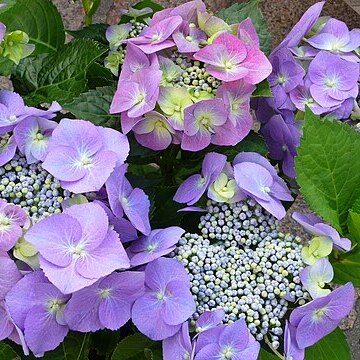Subshrubs, shrubs, or small trees, erect or climbing, deciduous or evergreen. Branchlets, leaves, and inflorescences variously hairy. Leaves opposite, rarely verticillate, exstipulate; leaf blade simple, margin entire, serrate, or rarely pinnately lobed. Inflorescence terminal, occasionally axillary, a corymbose cyme, umbellate cyme, or thyrse; bracts deciduous. Flowers fertile or sterile. Sterile flowers few (more numerous in cultivated varieties), sometimes absent, borne at margin of inflorescence, with sepals 2 or 5, petaloid, and enlarged. Fertile flowers usually very numerous, bisexual, small; pedicel short. Calyx tube adnate to ovary, 4-or 5-dentate, persistent. Corolla lobes 4 or 5, free, rarely connate and forming a calyptra, ovate or spatulate, valvate. Stamens (8 or)10(or 25), inserted on disc; filaments linear; anthers oblong to subglobose, apex subrounded to obtuse. Ovary inferior to 2/3 superior, imperfectly or perfectly 2-4(or 5)-loculed; placentation parietal or axile; ovules numerous. Styles 2-4(or 5), free or basally connate, persistent; stigmas terminal or decurrent along style adaxially. Fruit a capsule, dehiscing apically among styles, hemispheric to turbinate, small, apex projected or truncate. Seeds numerous, small, winged or wingless; seed coat thin, with reticulate or striate veins.
Woody climbers or shrubs, inflorescence and adjacent stem pubescent with stellate hairs, or tomentose with long, curling silky hairs. Leaves opposite, simple, blades penninerved, margins remotely denticulate or entire, oval, broadest near middle, petiole stout. Inflorescence cymose (in Central America), terminal, or occasionally lateral, subtended by chartaceous, caducous involucral bracts; sterile flowers showy, pink or white, not always present; fertile flowers white or maroon, small; hypanthium hemispheric; calyx-lobes 4, inconspicuous, deltoid; petals 4, oblong, valvate, deciduous during anthesis; stamens 8, occasionally 10, filaments long and filiform or short and inconspicuous, anthers oblong to somewhat rounded; ovary inferior, 2-to 4-celled, styles 2-4, erect and spreading, or occasionally co-herent in bud and early anthesis, continuing to elongate with the maturing capsule; stigmas terminal and more or less decurrent on inner surface; ovules numerous, borne on axial placentae; capsule 2-to 4-celled, truncate, thick-walled, dehiscent at apex between the spreading styles; seeds numerous, very small, linear, arcuate.
Fls ± epigynous, 4–5-merous except the 2–4(5)-locular ovary; fertile fls small, with minute sep, short pet, 8 or 10 stamens, and 2–4(5) short, stout styles; sterile fls consisting only of a large, white or colored, spreading cal of 3 or 4 sep; fr a capsule, consisting of the enlarged, strongly ribbed hypanthium enclosing the ripened ovary, tipped by the persistent styles and dehiscing between them; shrubs or woody vines with opposite (rarely whorled) lvs and numerous small fls in crowded cymes; fls all perfect, or the marginal sterile, or all sterile. 80, widespread.
Evergreen or deciduous shrubs, sometimes climbers. Lvs opposite, simple, often large, serrate or lobed, sometimes dotted with oil glands. Infl. terminal, corymbose or paniculate, sometimes enclosed in bud by large, ovate bracts. Calyx inconspicuous in fertile fls, that of sterile fls often with 3-5 spreading and petal-like sepals. Petals of fertile fls 4-5, white, blue or pink; petals of sterile fls often 0. Stamens usually 8-10. Ovary inferior. Capsule small, opening at top between persistent styles.


